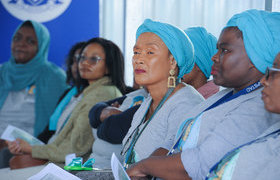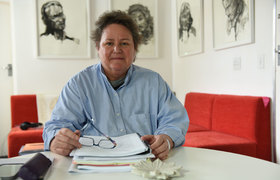Screen and treat essential to beat cervical cancer
02 November 2023 | Story Niémah Davids. Photo Je’nine May. Voice Cwenga Koyana. Read time 6 min.
In 2020 the World Health Organization (WHO) publicised a global strategy to accelerate the elimination of cervical cancer as a public health problem. To achieve this goal, the organisation recommends that 90% of girls be fully vaccinated with the human papilloma virus (HPV) vaccine by the age of 15; and that 70% of women be screened with a high-performance test by the age of 35.
For more than four decades, the University of Cape Town’s (UCT) Professor Lynette Denny – one of the country’s and continent’s leading cervical cancer researchers – has been at the forefront of this fight. During a recent conference, arranged to shine a spotlight on the advances in prostate and cervical cancer research – organised by the International Centre for Genetic Engineering and Biotechnology (ICGEB) – Professor Denny highlighted the importance of adopting effective screen-and-treat strategies to adequately address the burden of this disease on women.
“We started looking at alternative strategies to the pap smear because of our failure to make a dent on [the burden caused by] cervical cancer.”
Denny told the audience that her team at the Khayelitsha Cervical Cancer Screening Project (KCCSP), have for years been testing and evaluating alternative, effective methods to the pap smear – a well-known procedure used to test for cervical cancer. The KCCSP fast tracks research into cervical cancer prevention and treatment options and provides vital HPV screening and treatment. The clinic is located on the Khayelitsha Community Health Clinic precinct in Site B.
Evaluating alternative strategies
“We started looking at alternative strategies to the pap smear because of our failure to make a dent on [the burden caused by] cervical cancer,” Denny said.
Cervical cancer is the fourth most common cancer globally, and in 2020 claimed the lives of approximately 350 000 women. More than 80% of cases occur in low- to middle-income countries in sub-Saharan Africa, Melanesia, Asia and Southeast Asia. In South Africa, thousands of cases of cervical cancer are diagnosed annually, and the prognosis is seldom good.
Over the past couple of years, Denny and her team have explored several alternative techniques to the pap smear. One, she explained, included evaluating the effectiveness of visual inspection with acetic acid (VIA), both with and without magnification – a simple and inexpensive test used to detect cervical pre-cancerous lesions. The next alternative was exploring the use of visual automated evaluation using artificial intelligence and machine learning. This technique shows promise, but, said Denny, further investigation into its effectiveness is still required. The third option was assessing the feasibility of molecular testing using nucleic acid amplification (NAATs). NAATs is a unique HPV DNA test that checks the presence of specific cancer-causing strains, and this technique revealed some pleasantly surprising results.
“Using HPV NAATs as the primary screening test prevents cancer and saves more lives than [the use of] VIA cytology as the primary screening test,” Denny said. “[Therefore] the WHO now encourages the use of HPV NAATs once testing infrastructure is operational and affordable.”
Randomised control trial
While on a quest to locate effective, safe and affordable methods to prevent cervical cancer, Denny said the team designed a randomised clinical control trial to investigate the efficacy and feasibility of two specific screen-and-treat strategies. More than 6 000 non-pregnant women, who were previously unscreened for HPV, were recruited from clinics in Khayelitsha and participated in the study.
She said a group of women were randomly selected for an HPV [NAATs] screen-and-treat round, in which HPV-positive women received prior therapy; while the second group of participants followed a VIA screen-and-treat approach and HPV-positive women received prior therapy as well.
“Performance characteristics of HPV and VIA as the primary screening tests … you can see that [with] HPV testing, we [achieved] a 90% sensitivity [to detecting pre-cancerous lesions], 85% specificity, and a 99% negative predictive value. This is very important for national screening programmes.”
However, she pointed out that the VIA screen-and-treat results revealed a below 50% sensitivity to detecting pre-cancerous lesions, an 80% specificity and 97% negative predictive value.
“If we compare these two screen-and-treat strategies, to reduce the accumulative prevalence of CIN2+ [cervical cancer] by 36 months, we see that we needed 23 patients screened [with HPV NAATs] to prevent one case of CIN2, compared to 50 cases of VIA. This gives you a graphic description,” Denny said.
The way forward
However, she added, the right screen-and-treat strategy depends on the environment and the clinic’s location.
“The impact of cervical cancer and mortality must be measured and demonstrated. Without knowing the impact, the process of secondary prevention will fail.”
And as scientists and clinicians work towards winning the war on cervical cancer, Denny said there is an urgent need to meticulously evaluate screen-and-treat strategies, while keeping various contexts in the country, the continent and the world top of mind. Further, she said, performing situational analyses to assess these contexts prior to introducing the preferred strategy is essential to ensure that it will benefit the patient and “will not break the system”.
“We need to create a menu of options. What exactly is needed for successful [screen-and-treat] implementation? The ultimate goal is the elimination of cervical cancer as a public health problem,” Denny said. “The impact of cervical cancer incidence and mortality must be measured and demonstrated. Without knowing the impact, the process of secondary prevention will fail.”
 This work is licensed under a Creative Commons Attribution-NoDerivatives 4.0 International License.
This work is licensed under a Creative Commons Attribution-NoDerivatives 4.0 International License.
Please view the republishing articles page for more information.










